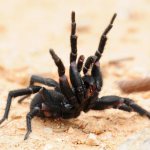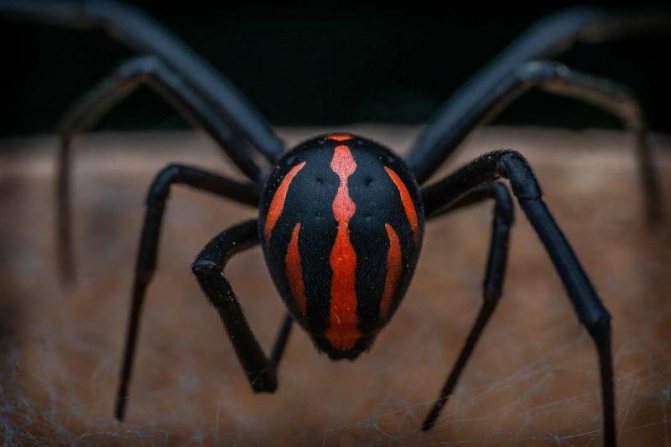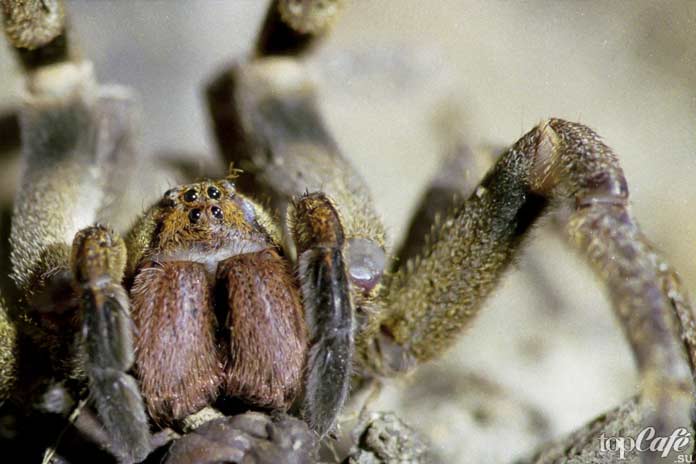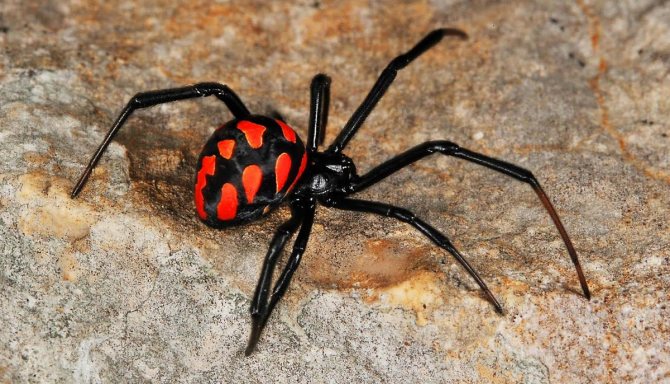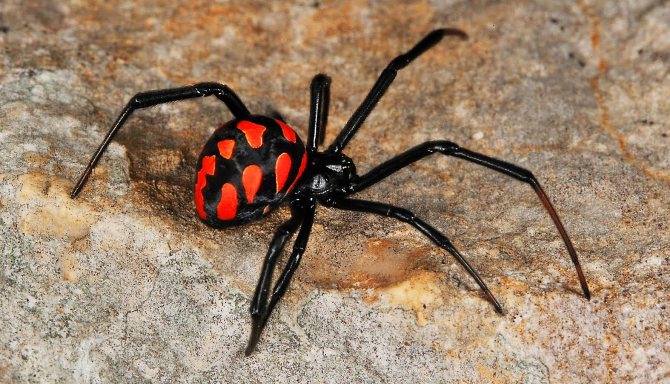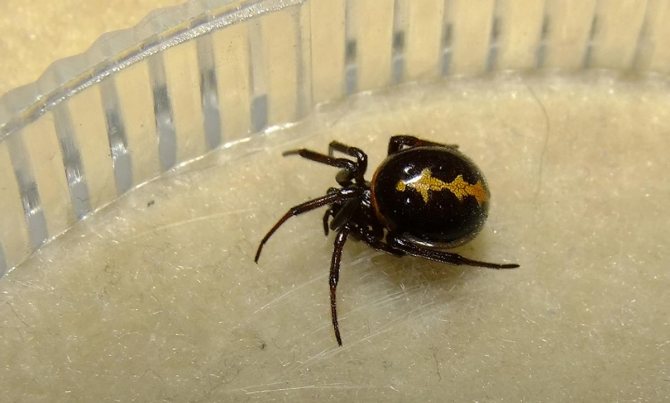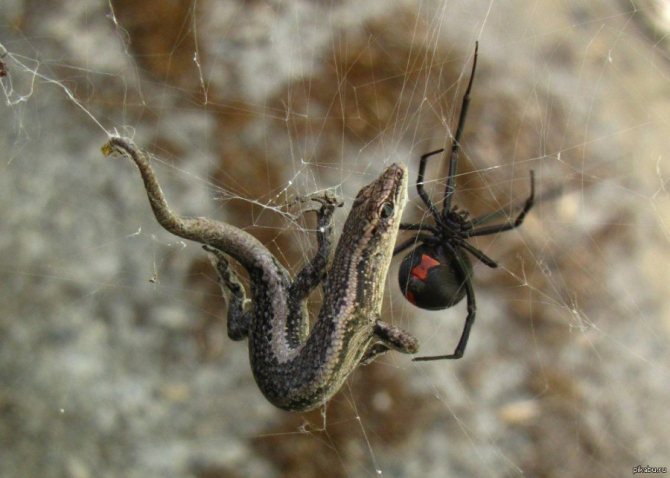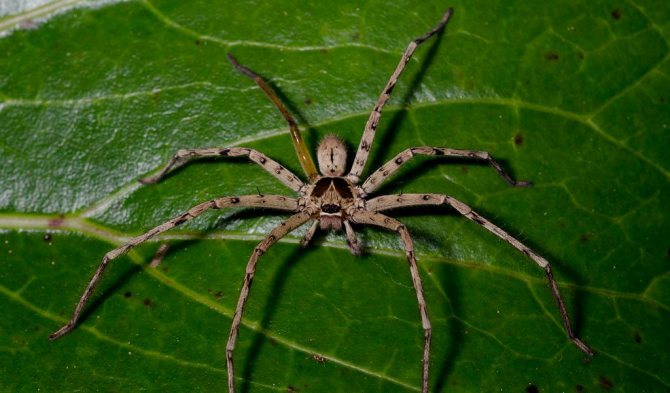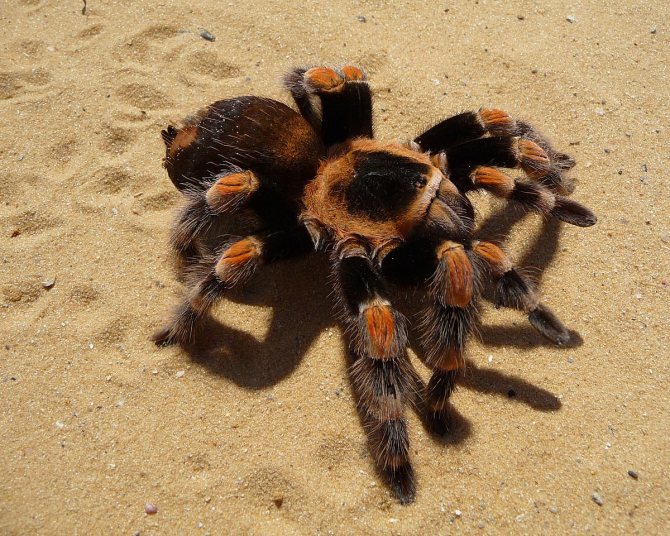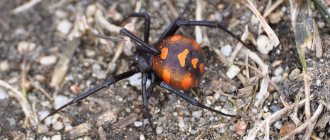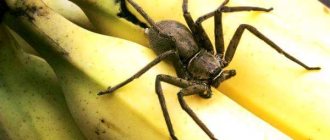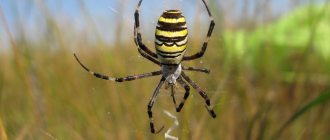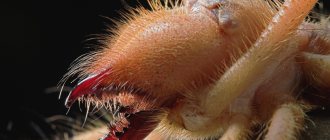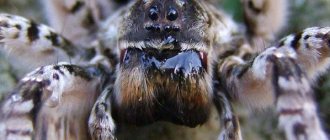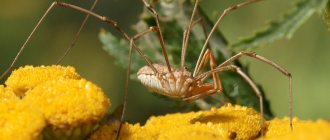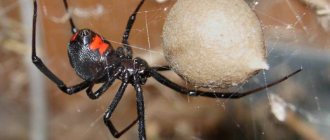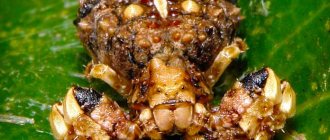Distribution of the Sydney funnel spider.
The Sydney funnel web spider lives within a radius of 160 kilometers from Sydney. Related species are found in Eastern Australia, South Australia and Tasmania. Distributed mainly south of the Hunter River in Illawarra and west in the mountains of New South Wales. Discovered near Canberra, which is located 250 km from Sydney.
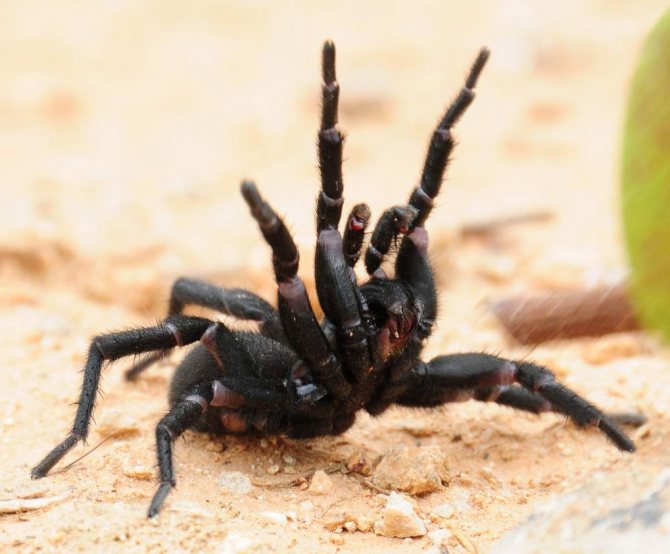
Atrax robustus
Habitats of the Sydney funnel spider.
Sydney funnel spiders live in deep gullies under rocks and in depressions under fallen trees. They also live in damp areas under houses, in various crevices in the garden, and compost heaps. Their white spider webs are 20 to 60 cm long and extend into the soil, which has stable, high humidity and low temperatures. The entrance to the shelter is either L-shaped or T-shaped and braided with spider webs in the form of a funnel, hence the name funnel spiders.
Brown Widow / Latrodectus geometricus


The brown widows are thought to be native to Africa, but the first specimen described lived in South America. Representatives of this species have settled in many parts of the planet. Populations of brown widows are found in southern California, the Caribbean, many US states on the Gulf Coast, as well as Japan, South Africa and Madagascar, Australia and Cyprus.
They can be found in residential buildings, in garages, inside old tires and under cars, and among bushes and other vegetation.
The poison of the brown widow is twice as strong as that of the black widow. However, this species is not aggressive. Even when bitten, spiders do not inject all of their venom. However, there were two recorded deaths from a brown widow bite in Madagascar in the early 1990s.
External signs of the Sydney funnel spider.
The Sydney funnel-shaped spider is a medium-sized arachnid. The male is smaller than the female with long legs, its body length is up to 2.5 cm, the female is up to 3.5 cm long. The integument is glossy blue - black, dark plum or brown, beautiful, velvety hairs that cover the abdomen. The chitin of the cephalothorax is almost naked, smooth and shiny. The limbs are thickened. Massive and strong jaws are conspicuous.
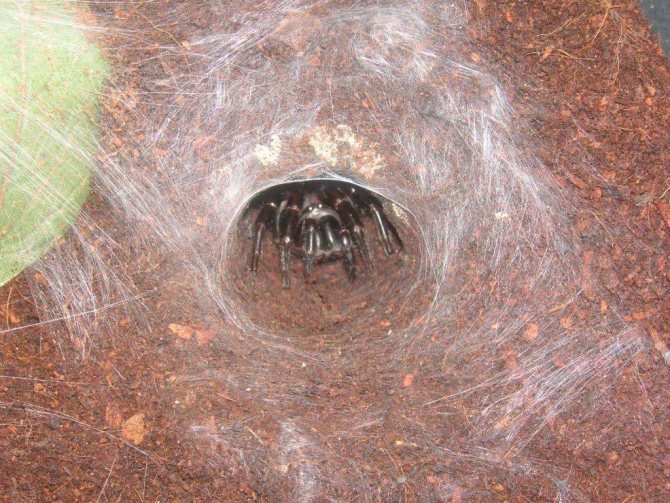

Breeding Sydney funnel spider.
Sydney funnel spiders usually breed in late summer or early fall. After mating, after a while, the female lays 90-12 eggs of a greenish-yellow color. Under unfavorable conditions, the seed can be stored for a certain time in the genitals of the female. Males are able to reproduce at about four years of age, and females a little later.
Classification
42 kinds of spiders:
- Acutipetala
Dankittipakul & Zhang, 2008 - Thailand (2 views) - Agelena
Walckenaer, 1805 - from Africa to Asia (69 species, 1 subspecies),
Agelescape caucasica - Agelenella
Lehtinen, 1967 - Yemen, Socotra (1 view) - Agelenopsis
Giebel, 1869 - North America (13 species) - Ageleradix
Xu & Li, 2007 - China (6 types) - Agelescape
Levy, 1996 - Southwest Asia (7 species) - Ahua
Forster & Wilton, 1973 - New Zealand (4 types) - Allagelena
Zhang, Zhu & Song, 2006 - from Central Europe to Asia (5 species) - Azerithonica
Guseinov, Marusik & Koponen, 2005 - Azerbaijan (1 view) - Barronopsis
Chamberlin & Ivie, 1941 - USA, Cuba, Bahamas (7 species) - Benoitia
Lehtinen, 1967 - from Africa to Asia (9 species) - Calilena
Chamberlin & Ivie, 1941 - USA (16 species, 5 subspecies) - Hadites
Keyserling, 1862 - Croatia (1 view) - Histopona
Thorell, 1869 - Europe (18 species) - Hololena
Chamberlin & Gertsch, 1929 - USA (30 types) - Huangyuania
Song & Li, 1990 - China (1 view) - Huka
Forster & Wilton, 1973 - New Zealand (5 types) - Kidugua
Lehtinen, 1967 - Congo (1 view) - Lycosoides
Lucas, 1846 - North Africa (10 species) - Mahura
Forster & Wilton, 1973 - New Zealand (18 species) - Maimuna
Lehtinen, 1967 - Southwest Asia (7 species) - Malthonica
Simon, 1898 - Eurasia, Africa (41 species, 1 subspecies)
Malthonica lehtineni - Melpomene
O.P.-Cambridge, 1898 - from the USA to Central America, Costa Rica (12 species) - Mistaria
Lehtinen, 1967 - Africa, Yemen (1 species, 1 subspecies) - Neoramia
Forster & Wilton, 1973 - New Zealand, Campbell Islands (22 species) - Neorepukia
Forster & Wilton, 1973 - New Zealand (2 types) - Neotegenaria Roth, 1967 - Guiana (1 species)
- Novalena
Chamberlin & Ivie, 1942 - from USA to Central America (19 species) - Olorunia
Lehtinen, 1967 - Congo (1 view) - Oramia
Forster, 1964 - from Australia to New Zealand, Lord Howe, Chatham (8 species) - Oramiella
Forster & Wilton, 1973 - New Zealand (1 view) - Orepukia
Forster & Wilton, 1973 - New Zealand (24 species) - Paramyro
Forster & Wilton, 1973 - New Zealand (2 types) - Porotaka
Forster & Wilton, 1973 - New Zealand (2 types) - Pseudotegenaria
Caporiacco, 1934 - Europe (5 types) - Rualena
Chamberlin & Ivie, 1942 - from USA to Central America (12 species) - Tararua
Forster & Wilton, 1973 - New Zealand (7 species) - Tegenaria
(Tegenaria) Latreille, 1804 - USA, Eurasia (110 species) - Textrix
Sundevall, 1833 - Europe (7 types) - Tikaderia
Lehtinen, 1967 - Himalayas (1 view) - Tortolena
Chamberlin & Ivie, 1941 - USA, from Mexico to Costa Rica (2 views) - Tuapoka
Forster & Wilton, 1973 - New Zealand (2 types)
Behavior of the Sydney funnel spider.
Sydney funnel spiders are mostly terrestrial arachnids, preferring wet sand and clay habitats. They are solitary predators, except for the breeding season. Females tend to live in the same area as long as their shelter is not flooded with water during the rainy season. Males tend to roam the area in search of a mate. Sydney funnel spiders hide in tubular holes or crevices with jagged edges and exit in the form of a "funnel" woven from a web.
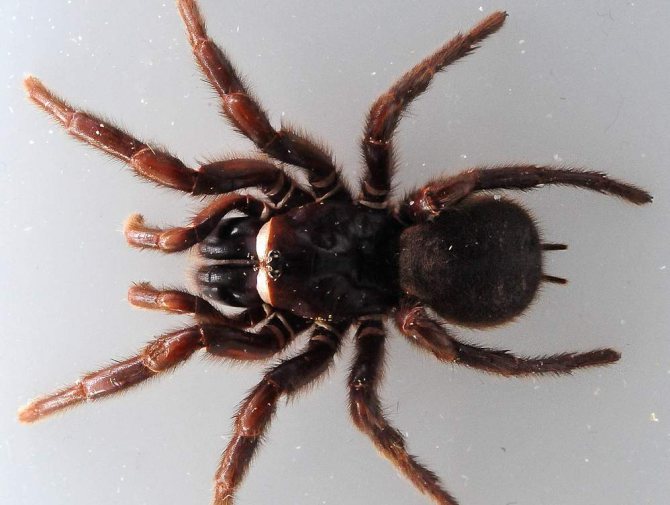

In a number of exceptions, in the absence of a suitable place, spiders sit simply in openings with a spider-web inlet pipe, which has two funnel-shaped holes.
The lair of the Sydney funnelpack can be in the hollow of a tree trunk, and raised a few meters from the surface of the earth.
Males find females by excretion of pheremones. During the breeding season, spiders are most aggressive. The female waits for the male near the spider's funnel, sitting on a silk lining in the depths of the burrow. Males are often found in wet places where spiders are hiding, and fall into bodies of water accidentally during their travels. But even after such a bath, the Sydney funnel spider remains alive for twenty-four hours. Taken out of the water, the spider does not lose its aggressive abilities and can bite its accidental rescuer when released on land.
Karakurt
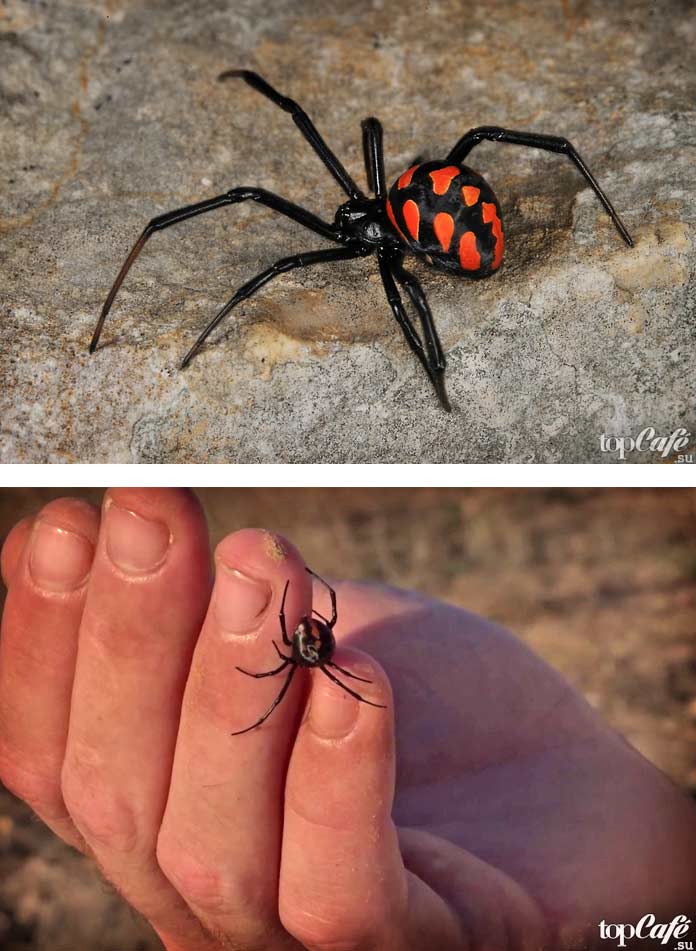

It can be easily confused with a black widow due to its physical resemblance. But Latrodectus tredecimguttatus is still larger in size. They prefer to avoid living near human dwellings, they are distinguished by a peaceful disposition. They only attack when disturbed. And this is not an attack, but self-defense. Large horned animals often become victims of this species. There are known cases of people being bitten by Latrodectus tredecimguttatus. There have even been cases of fatal bites.
The bite of karakurt is very painful. The victim experiences severe pain and burning. And after 10-15 minutes, when the poison spreads throughout the body, people begin to suffer from pain in the lumbar region, press or chest. All this is often accompanied by headaches, shortness of breath and vomiting.
I wonder how the person in the photo is not afraid to hold this dangerous karakurt? Maybe he's holding a dead spider?
Feeding the Sydney funnel spider.
Sydney funnel spiders are real predators. Their diet consists of beetles, cockroaches, insect larvae, land snails, millipedes, frogs, and other small vertebrates. All prey falls on the edges of the spider webs. Spiders weave trapping nets exclusively from dry silk. Insects, attracted by the glitter of the cobweb, sit down and stick. The funnel spider, sitting in ambush, moves along the slippery thread to the victim and eats the insects trapped in the trap. He constantly extracts prey from the funnel.
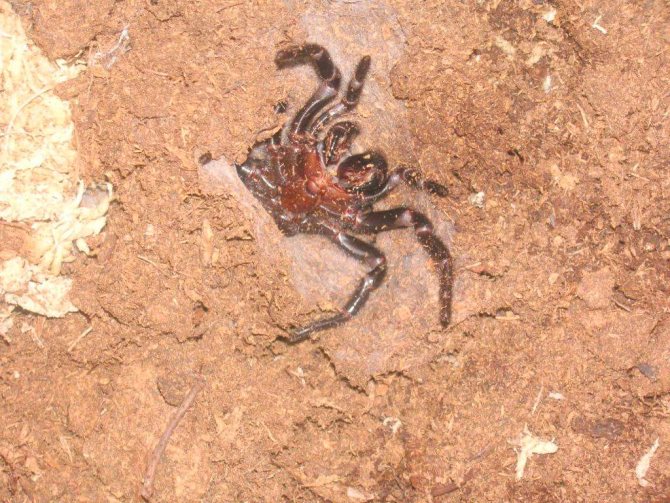

Bishop's Widow / Latrodectus bishopi
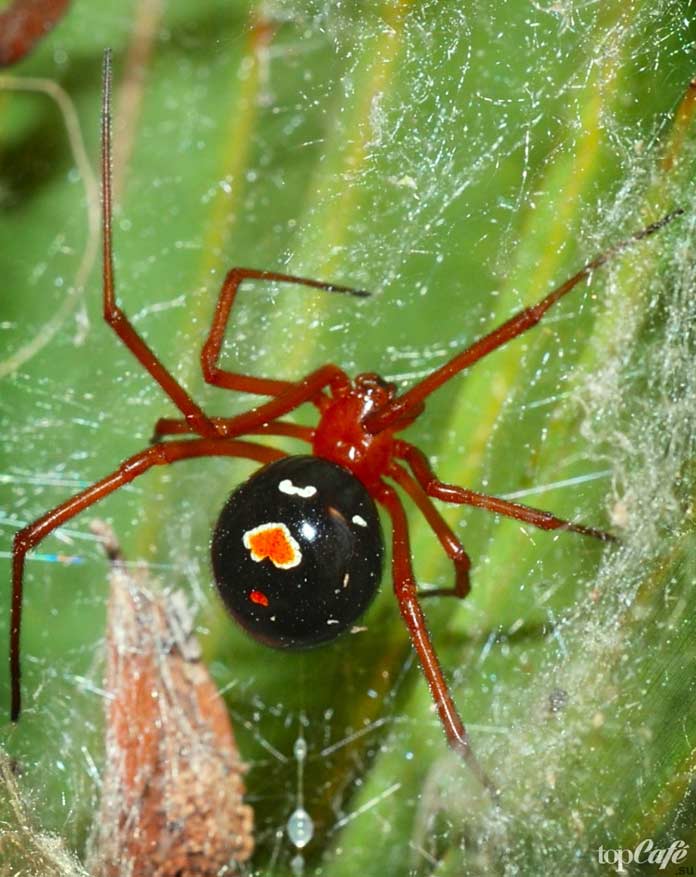

This is a rare species of black widows that live in Florida, USA. They feed on insects and are not considered aggressive towards humans. However, human bites do occur when widows protect their eggs or when a person is accidentally caught in a spider's web.A red widow bite is similar to a black widow bite and has identical symptoms (pain, cramps, nausea, etc.). Deaths from the bite of the red widow are rare, as the spider injects such a small amount of venom. Young children, the elderly and people with health problems are most vulnerable to red spider bites.
The Sydney funnel spider is dangerous.
The Sydney funnel web spider secretes a venom, the compound atraxotoxin, which is highly toxic to primates. The venom of a small male is 5 times more toxic than that of a female. This type of spider often settles in gardens near a person's dwelling, and crawls inside the premises. For some unknown reason, it is the representatives of the order of primates (humans and monkeys) that are especially sensitive to the poison of the Sydney funnel spider, while it does not act fatally on rabbits, toads and cats. Disturbed spiders provide complete intoxication, throwing poison into the victim's body. The aggressiveness of these arachnids is so high that they are not advised to approach them too close.
The chance of getting a bite is too great, especially dangerous for young children.
Since the creation of the antidote in 1981, Sydney funnel spider bites are not nearly as life-threatening. But the symptoms of the action of the toxic substance are characteristic: severe sweating, muscle cramps, profuse salivation, increased heart rate, increased blood pressure. Poisoning is accompanied by vomiting and pallor of the skin, followed by loss of consciousness and death, if the medicine is not administered. When providing first aid, a pressure bandage should be applied above the bite site to reduce the spread of poison through the blood vessels and ensure complete immobility of the patient and call a doctor. The distant state of the bitten person depends on the timeliness of the provision of medical care.
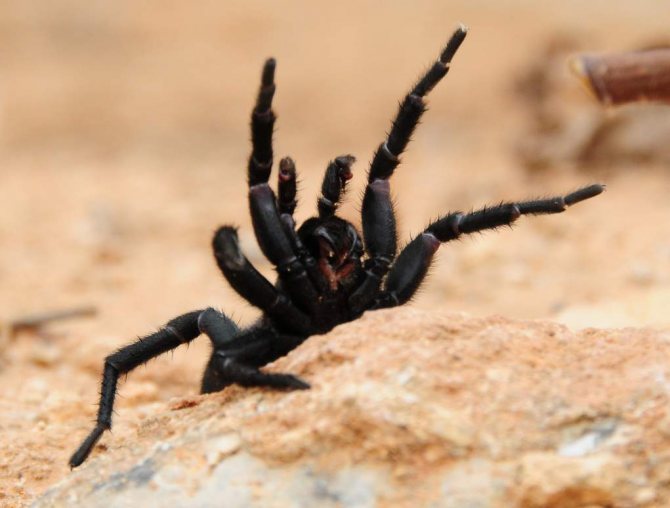

Conservation status of the Sydney funnel spider.
The Sydney funnel spider does not have a special conservation status. In the Australian park, spider venom is obtained for testing to determine an effective antidote. More than 1000 funnel spiders have been studied, but such scientific use of spiders is unlikely to lead to a sharp decline in numbers. The Sydney funnel spider is sold to private collections and to zoos, despite its poisonous qualities, there are lovers who keep spiders as pets.
If you find an error, please select a piece of text and press Ctrl + Enter.
Tarantula
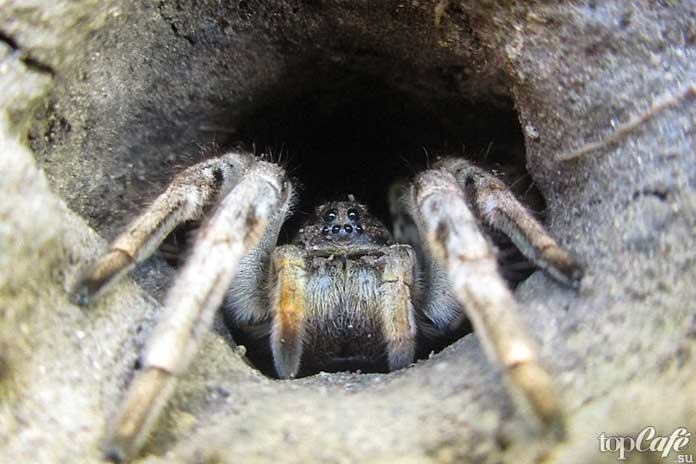

Belongs to the wolf spider family. The tarantula can be found wherever it is warm and humid. Lycosa live more than 30 years and are considered real long-livers. They feed on small mice, toads, insects, Bites are very painful, but not fatal. Often in people bitten by tarantulas, the area near the bite becomes yellow for several months.
Currently, more than 200 species of tarantulas are known. If you like, TopCafe will write an article about the most beautiful tarantulas. Write in the comments if you want to admire her.
Most popular representatives
They are represented by a large number of representatives. Each spider is endowed with certain capabilities and is perfectly adapted to life in its region. Due to the fact that climatic changes have been observed in the last decade, the geography of arthropods is changing. Species that previously occupied only certain regions migrate and populate new territories.
Jumping spider
The jumping spider is found throughout Russia and is considered one of the best gardeners' helpers. Its advantage is the inability to bite through the human body. You can get such a spider on your site to combat garden pests. It is enough to catch a few individuals and plant them in a garden bed or under a tree. The horse will not be at a loss - it will immediately begin to twist a web and settle in a new place.
Pizaurid
They live in Siberia and the Far East. This species is mainly characterized by giving gifts during courtship. The male, when preparing for a meeting with his beloved, carefully packs the caught flies or midges into a spider's cocoon. Such an offering reduces the likelihood of being eaten and increases the chances of mating.
Cross fittings
The crosses are one of the most common species of the orb weaving family. They inhabit the entire territory of the Russian Federation, make a great contribution to the fight against harmful insects and easily adapt to a new place of residence.
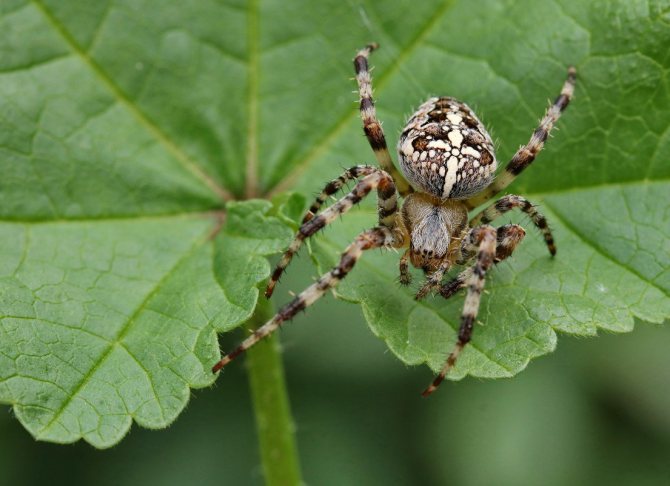

Hermit spider
A tiny spider, no more than 8 mm in size, with a leg span of up to 2 cm. A distinctive feature of the cross is its wide paws and a striped elongated body, with a characteristic pattern in the form of a cross. The color ranges from brown to dark brown.
The recluse spider spins its webs randomly, as necessary. It is formed by careless and chaotic movements during the weaving process. A hermit bite is not fatal. But its poison contains substances that strongly break down the skin, this threatens with necrosis (death) of tissues.

